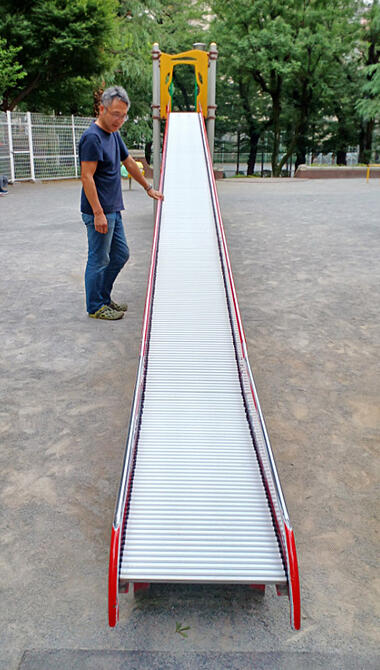According to knowledge gained from high-school physics, boxes of different weights placed on a slope slide with the same acceleration because the friction coefficient is constant. However, Professor Jiro Murata of the College of Science at Rikkyo University perceived a contradiction between this knowledge and empirical observations that suggested that 'heavier individuals (adults) slide down a playground slide faster.' As a result, he decided to investigate this contradiction as the topic for the graduation thesis of a student. As a result of his research, he discovered that as the weight of the box increases, its speed on the roller slide also increases; at a certain point, all boxes lose acceleration and slide at a constant speed (terminal velocity). This research is an example of exploratory learning, which allows for the discovery of phenomena that deviate from established laws.
In high-school physics textbooks, the free fall phenomenon is typically illustrated using examples such as a feather and a hammer falling simultaneously on the moon, where there is no air resistance, or a heavy lead ball and a light lead ball falling at the same time from the Leaning Tower of Pisa. Free fall is defined by the equation of motion F = ma, where F is force, m is mass, and a is acceleration. On earth, a is gravity, denoted as g. Similar to free fall, textbooks introduce the phenomenon of a box sliding down a slope. In this scenario, it can be demonstrated that frictional force is proportional to mass. In exam questions, students are provided with friction coefficients, denoted as µ, for objects at rest and in motion, respectively. Using this constant µ, they must calculate the frictional force. In this scenario, heavy and light boxes both slide down slopes with the same acceleration, similar to free fall.

Provided by Murata
However, Murata, a specialist in elementary particle, nuclear, and gravitational physics at Rikkyo University, made a discovery in 2022 while researching the curvature of curling stones. He found that the friction coefficient when an object is in motion is not constant in the real world. Intrigued by experiences from his own life, he wondered why adults move faster when they slide down a slide with children, and he hypothesized that the friction coefficient might be involved. As a result, he decided to conduct an experiment as part of the graduation thesis of a university student.

In his experiments, the roller slide and a camera were fixed in place by attaching a smartphone to a park fence. A video was taken of a cardboard box with a PET bottle filled with water inside sliding down the slide. By changing the number of PET bottles, the weight of the box was adjusted to be 1.0, 2.2, 4.2, and 6.2 kg. Videos registering these boxes sliding down the slide were analyzed frame by frame to measure their position. From the differences in position, velocities and accelerations were calculated.
According to the equation F = ma, each box should continue to accelerate indefinitely; however, in reality, they reached a terminal velocity from which they no longer accelerated. The terminal velocity was 0.5 m/s for the 1.0-kg box, 0.8 m/s for the 2.2-kg box, 1.2 m/s for the 4.2-kg box, and 1.4 m/s for the 6.2-kg box, with the heavier boxes being faster.
Murata stated, "In textbooks, the dynamic friction coefficient is taught as a constant value; however, in reality, it can be interpreted to have both velocity and mass dependencies." He added, "In textbooks, a single arrow in the opposite direction to the motion indicates frictional force. However, in reality, various pathways of energy dissipation, such as rotational motion of roller axes, deformation, vibration, rotational motion of bearings, and the flow of lubricating oil, are likely involved in this phenomenon."

Provided by Murata
To investigate whether this characteristic of terminal velocity occurs not only on roller slides but also on other types of slides, a similar experiment on a metal plate type slide was conducted in the thesis. The results varied, and there was no correlation between the weight of the box and its speed. Consequently, Murata stated that he has to redo the experiment rigorously.
Regarding the question 'Why do adults slide down a slide faster than children?' Murata found numerous explanations on the Internet, including those attributing it to air resistance. However, in his research, the conducted experiments revealed that air resistance is not significant and has no effect.
The research findings of this thesis, prompted by questions arising from the contradiction between high-school physics knowledge and real-life experiences, serve as a practical example of exploratory learning for university students regarding friction on slides. These results were published on June 6, 2023 in Journal of the Physics Education Society of Japan, a journal of the Physics Education Society of Japan.
Original article was provided by the Science Portal and has been translated by Science Japan.




